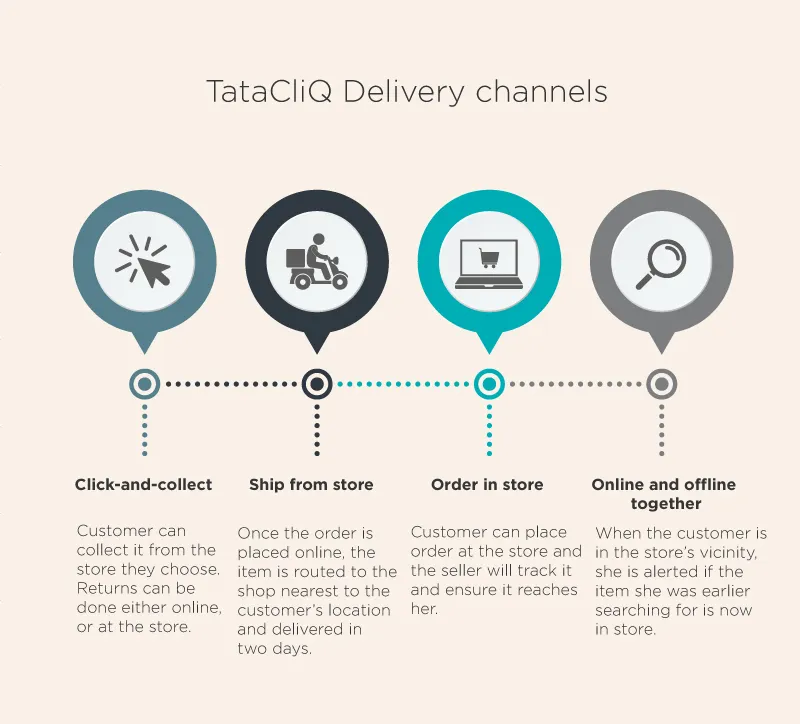How TataCLiQ achieved what Flipkart and Amazon could not
If Amazon gave the world e-commerce, Flipkart made it mainstream in India.
Thanks to these two etailers, the mobile/computer-savvy Indian today is not only comfortable shopping online but even prefers it.
Following in their wake, a multitude of online marketplaces have come up, both in horizontals (Snapdeal, ShopClues, etc.) and in verticals ranging from fashion to furniture.
But profitability has eluded these players so far even as billions of dollars have been poured in them over the last few years. Over-the-top marketing and discounts have ensured customer acquisition but at the cost of high cash burn.
While these ‘disruptor’ startups may have blazed a new trail in retail, they have something to learn from the veterans in the space.

Let's consider the Tata Group, the 150-year-old salt-to-software conglomerate. It entered online retail only a year ago with its e-commerce portal TataCLiQ, after careful consideration of scale and costs.
TataCLiQ has done a few things differently from other marketplaces. For one, it introduced the first real omnichannel experience in India called ‘phygital’. Two, it sells only fashion and electronics, and is working on adding more categories.
But most importantly, it claims it is close to breaking even and turning profitable, if the company is to be believed.
So what is it that Amazon (born quarter of a century ago in the US), Flipkart (which turns 10 this year and is regarded as India’s #1 startup) and Snapdeal (currently fighting for survival) can learn from TataCLiQ?
Read on to find out.
Challenging strength in numbers
Amazon, Flipkart, and ShopClues claim to have lakhs of sellers on board. The logic of having such a broad base of sellers is that they compete with each other for sales, which means the customer gets the best prices. Discounting, however, is not a sustainable model in the long run.
TataCLiQ decided it wasn’t going to have a large base of sellers. It started out by being completely brand-focused and onboards only brand-authorised sellers. And although it does offer discounts, lower prices are neither their USP nor critical to expansion.

Ashutosh Pandey, CEO of Tata CLiQ, says: “Our discounting is integrated across the online and offline stores. We do not manage the pricing of the product. This is very evident because our average selling price (ASP) for apparel is twice that of other platforms. Our relationship with brands allows us to delight our consumers by providing them value-added services (in the case of electronics) such as increased warranty, insurance, free installation, etc.”
Of the 800 brands that Tata CliQ has tied up with, the ‘phygital’ effort involves 50 brands, including Croma, Westside, Titan, FCUK, Police, Esprit, Metro, Vero Moda, ONLY, and Global Desi.
Stress on selection and authenticity
Flipkart, Myntra, ShopClues, and Amazon boast of thousands of brands—international and local. Their goal is to have everything for everyone, whether in the budget range or premium. Not all their sellers are authorised re-sellers of the merchandise they put up for sale, which increases the chances of fake products making their way to customers. TataCLiQ onboards only authorised re-sellers.
Ashutosh claims they have not had even one fake product complaint in the last one year because the brands themselves, and the sellers whom they have authorised, manage the merchandising. This is one lesson that other marketplaces can learn. While all marketplaces have battled widespread allegations of selling fake products, ShopClues, for instance, has been in the eye of that storm in the past.
Quality beats quantity. TataCliq does not deal in the commoditised space either. For the regular marketplaces, products with a low ASP (read unbranded, or local labels) bring in large business volumes.
Ashutosh says:
“We don’t sell t-shirts for Rs. 100 unless it is from a brand like UCB. We don’t want undifferentiated products. We are an online mall.”
TataCliq’s own market research and brand partners’ data contribute to their intelligence in choosing the brands they onboard. At the core are the 10-15 brands their customers have in their wardrobe and in their homes.
“Our customers are more affluent and older than regular online shoppers and mostly women in the 27-45 age group. They are the mall-going, brand-aware group,” Ashutosh adds.
Labels: Less of private, more of exclusive
While others look for profitability via private labels in fashion (Flipkart just launched Divastri while Amazon already has Myx and Symbol), Tata Cliq has no plans for private labels for now.
“Private labels bring up a conflict of interest because you start pushing that one over the others. We don’t want to compete with our (existing) brands. At some stage, we might do it. But before that, the business of the core brands has to increase manifold. A lot of brands already do private labels exclusively for us, like Westside which offers lines such as Vark, Utsa, Zuba, Bombay Paisley, Westsport, Nuon, etc.”
TataCLiQ Luxury also has exclusive deals with 13 brands, including Hugo Boss, Armani Jeans, Coach, Furla, Michael Kors, and Armani Exchange. Monthly revenue, it claims, has been growing at 300 percent each month for the past one year.
Further, domestic brands such as Croma, Zudio, and Okhai are also available only on TataCLiQ (besides their own websites), which plans to add 8-10 more brands that will be exclusively available only on their site by the end of the year.
Customer comfort: Show them what they’re looking for
Any online shopper—especially of fashion—would vouch for the fact that using multiple filters to choose one item from thousands is no fun. Since lifestyle is a huge category, personalisation is essential. In fact, Flipkart has rebuilt their interface to ensure just this.
Rishi Vasudev, Head of Fashion at Flipkart, told YourStory in an earlier interaction: “If you are buying a kurti, you don’t have to sit through thousands of products. Your screen will show you options to filter. If you want to buy sunglasses, you are asked if you are looking to buy wayfarers, or cat eye, etc.”
Tata CLiQ takes this filtration one level higher. The team curates only those brands that they think customers will like, i.e., instead of 45,000 shirts, a customer gets to see only 300, but these are the ones from brands they’re likely to buy and therefore more relevant. They are watchful about the choice of categories too.
For example, says Ashutosh, since there are few brands in sarees, they were slow to move in that category. “But we noticed that despite the small number, customers were still searching for Nalli, so now we are working with Nalli. We keenly watch what our customers are searching for and then put it on the site,” he says
Mastering supply chain and delivery
Although Flipkart and Amazon have exclusives in electronics and mobile phones, omnichannel benefits fashion the most, since the try-on [touch and feel] aspect is more important here. The true omnichannel retail experience would be if a customer can browse for fashion, try it out, and then order what you liked online and have it delivered.
In omnichannel, the entire process of identifying a product, browsing, showing interest, purchasing, and delivery can be done across any channel—either offline or online as the customer prefers. TataCLiQ has an advantage here. While Flipkart and Amazon have larger warehouses and control the supply chain, TataCLiQ’s is dis-aggregated, as their inventory resides at partner stores.

Every seller who ties up with TataCLiQ for ‘phygital’ commerce has to on-board all of their stores on its portal. This helps route orders to the store nearest to the customer, and ship it from there directly. They claim to deliver orders in 24-48 hours for 90 percent of local orders.
Ashutosh adds: “If the store nearest to the customer does not have the product ordered, we will get it from the next-nearest one. Since this is intra-city delivery, it costs us only half as much as others.”
Currently, 50 percent of all orders are fulfilled by the network of 1,000 ‘phygital’ stores, which are shipped straight out of stores or collected by customers themselves from a store of their choice. Although Flipkart and Amazon have tied up with offline kirana stores for delivery of groceries, neither has an omnichannel partnership with their sellers.
According to logistics expert Manish Saigal, managing director at Alvaraz & Marsal, a global performance improvement consultancy, a two-to-three-hour delivery window is an essential disruption for e-commerce industry. “Any store with a two to three kilometre reach, hyperlocal deliveries, or even robotics like drones will be the way to do it,” he says.
Omnichannel is easier said than done
In the US and the UK, Tesco and Walmart are successful in omnichannel because customers can order online and collect the products from stores. They have multiple stores in every city. But in India, it will take time to stabilise this because there are not enough stores to go and collect orders from. Ashutosh says that there are dark areas even in cities like Mumbai and Bengaluru. “So we will not go for a model which calls for indiscriminate scale,” he states.
But TataCLiQ has other hurdles.
The name Tata brings with it a lot of credibility and trust; it also adds to the responsibility. For instance, if escalations in social media are unresolved even after two days, Ashutosh steps in to close these out himself.
“If anything is open after 10 days, our Executive Director will speak to the customer directly. But there are no brownie points (for this) because there are no fake products on our site. That’s a given,” Ashutosh adds.
The need for advanced technology
Omnichannel will take years to grow roots in India, given that it demands significant investment in technology and organisational alignment.
Interestingly, Snapdeal launched its omnichannel initiative in October 2015 through which customers could order products online and avail faster hyper-local fulfilment by offline retailers. With efficient implementation, it could have given Snapdeal a turnaround, but the experiment failed to make waves, reportedly due to strategic mismanagement and a lack of resources.
The capital required for creating a strong physical presence like offline retailers is significant. Physical retailers like Aditya Birla, Tata, and Reliance have also invested large amounts in the last 15 years to set up an expansive network of stores. E-commerce players will also have to do the same to be able to compete with them on an equal footing.
But online and offline are just different channels for retail, and each retailer has to choose which channel, or combination of channels, to use in terms of stores, catalogues, websites, etc.
Retail expert Devangshu Dutta, Chief Executive at Third Eyesight management consultancy, says: “In the case of strategies like exclusives, department stores and multi-brand outlets, it depends on the brands’ perspective and how they want their products to reach the customer.”
“The advantages for omnichannel will come in the long term, because you are in front of the consumers constantly. They see you everywhere, whether offline or online; you capture that much mind space,” he adds.
So why are Flipkart and Amazon not following this model yet?
Devangshu believes it is a question of time and priorities for Flipkart and Amazon. Amazon has delivery centres and (offline) stores in the US already. He feels that Amazon will also integrate Whole Foods with the online business soon.
“Flipkart too will have to start doing this. Viable scale is more important than absolute scale here,” he adds. In the last year and a half, Flipkart has been making an all-out effort to improve margins. Amazon, meanwhile, has learnt its lessons from a wider geography. It has had its failures—against Alibaba in China and Coupang in Korea (the latter offers same-day delivery for online orders).
What can’t be ignored is that Tata CLiQ is a domestic business and has no pressure from international investors. Flipkart and Amazon do need to scale up, as they have foreign money and are hard-pressed to show returns on the cash burnt.
It is time, then, for at least a selection of products—if not only branded items—to be given the omnichannel push, which in turn is sure to improve customer acquisition and retention.
At 10 years old, e-commerce is still young in India. With Flipkart and Amazon being real fighters, more models and innovations are sure to emerge and change the future of retail in India.
(Disclaimer: Ratan Tata, Chairman of Tata Sons which is the holding company of Tata Cliq, is an investor in YourStory.)







